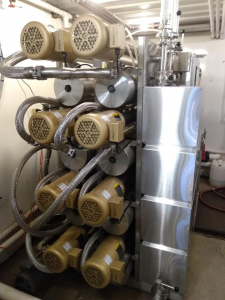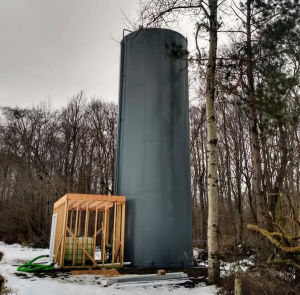I was recently in western New York, near Buffalo and the Canada border, and was able to tour my first maple syrup farm!
It’s something we don’t always think of — and it’s something we frequently take for granted. You may see several kinds of maple syrup in the grocery store, but how significant is the difference between them? When it says PURE, is it really? If it says it’s from Vermont, is it really? How truthful are labels?
I would say that there can be a pretty big difference, and knowing where it comes from matters! Some maple syrup brands use more high fructose corn syrup and maple flavoring than others that may be more pure. There’s different sugar and calorie content for various brands, and numerous factors that go into syrup. At this maple farm I visited, this is the good stuff.
The farm belongs to my friend Nikki Boxler and her family, and behind me in this photo is a picture of the tapped trees.

Maple syrup (tree sap) flows best after a hard freeze and after the weather warms up. Maple trees have the hole poked in them and sap flows throw the lines you see behind me, usually about 30 days a year. The sap flows through the system and ends up in buildings for processing. Sugar content from trees may vary, but on average it’s 1.7 to 2.2 percent, depending on elevation, growing conditions, and other factors. Fun fact: It takes 52 gallons of sap to produce 1 gallon of pure maple syrup! This is why the purest maple syrup can carry a higher price tag.
Springtime (when the trees start to have buds) is the best time for harvesting sap for syrup. The lines are usually cleaned once a year after harvest and permanently replaced about every 10 years. After the sap is collected, the trees are allowed to “heal” and will be tapped in a different location on the tree next time. Think of it almost like giving blood, the way trees are tapped in different places.
A lot of work goes into maple farms. Another thing to think about is that the trees are scouted every day to monitor the lines and make sure everything is going smoothly and that there’s no leaks. If there is, you can generally hear it! It was cold the day with a lot of snow when I was out there, so good boots and winter gear were a must!
After sap is collected (multiple times a day!) it goes through an extensive process of reverse osmosis, boil down to evaporate, test, store, etc. Here is a photo of their reverse osmosis equipment:

Maple syrup and sap is stored, too. Here is their silo, which holds 30,000 gallons of sap! It’s picked up multiple times a day to be processed into pure maple syrup.

Although Boxler Maple sells their maple syrup direct to the public and through agritourism efforts, a lot of it is sold wholesale and trucked to places like Canada or Vermont to be sold. Yes, sometimes when syrup says “product of Vermont,” it doesn’t necessarily mean that the syrup was produced there. Just finished and sold under that label.
Still, you can be certain when the label says PURE Maple syrup, there’s definitely a difference and a reason for the higher cost of production. A whole lot of work and time goes into syrup production!
Michelle Miller, the Farm Babe, is an Iowa-based farmer, public speaker, and writer, who lives and works with her boyfriend on their farm, which consists of row crops, beef cattle, and sheep. She believes education is key in bridging the gap between farmers and consumers.



